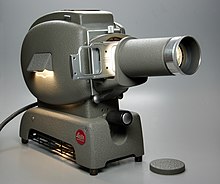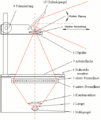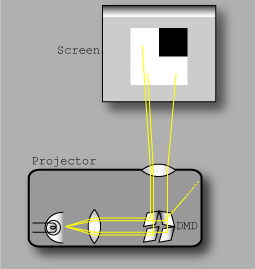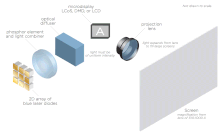projector
A projector ( lat. Proicere "forward throw throw") is an optical device with which a two-dimensional template (usually on a surface on an image screen ) displayed is. In contrast to photography , the image is not shown with the light of external light sources. In addition to a lens, a projector contains its own light source. The template is an image generated photographically or otherwise. It is transparent ( slides , photo negatives ) or not transparent (book pages, manuscript papers, paper pictures ) , stationary or moving ( cinema film ). It is usually shown enlarged. In work projectors, the template is typically projected during its creation (writing and drawing on transparent film).
Projectors for connecting digital template sources such as computers are called video projectors or beamers for short . In place of the template, such a projector has a device that converts the code of the electronic template into a light image (for optical imaging by means of a projection lens it is the object).
Laser projectors do not have a template that is projected. An image is generated on the image surface by controlling a laser beam.
Back and back light projection
The terms back- light projection and front-light projection refer to the type of illumination of the original to be projected.
Backlight projection
Other transmitted light projectors are microfilm readers , overhead projectors , gobos , film viewer and enlargers .
With back light projection, the object to be projected - for example a slide - is translucent. The light from the projector's own lighting device shines through it. The lighting can be optimized by means of the lighting beam path intertwined with the imaging beam path: greatest brightness, uniform lighting across the original.
Front projection
In front-light projection, opaque documents (flat objects, paper pictures or illustrations from books) are projected. In contrast to transmitted light projection, the original is illuminated and seen from the side facing the image surface. There is also a mirror in the beam path so that the original is not mirror-inverted. Since only the light reflected from the original is available for imaging, the projection result is much less bright than with back-light projection. The device's own light source is usually not directed vertically onto the original in order to avoid blinding spots in the image when the original surface is glossy. The illumination beam path and the imaging beam path are in principle independent of one another.
Template decoding
The decoders act according to the image to be displayed on light from a light source contained in the projector. The light is selectively deflected into the optical path of the lens (mirror in the on / off position or continuously variable degree of reflection). Other decoders let light pass or not (positions open / partially open / locked).
Modern devices for decoding (electro-optical conversion) and large-area projection of an image originally stored electronically are variants of the classic projection devices. With them, the decoding device takes the place of the, as a rule, unchangeable real pictorial template. The decoders are a small-area deformed oil film in the Eidophor device, a small-area adjusted micromirror array (DMD for short) or a liquid-crystal-on-silicon ( LCoS for short ) matrix display in the video projector, the incident light depending on the deformation of the oil film or the Reflect the position of the mirror or the deformation of the liquid crystal molecular structure of the LCoS pixels. Another common type of decoding is done with video projectors using LCDs that let light through or not. The corresponding projectors are computer output devices that display large areas.
An analog composite image is generated with the eidophore device. Since around 2005, video projectors have only been generating digitized (pixel) images with the above-mentioned construction methods.
Laser projection
With laser projection, raster or vector-oriented graphics can be generated directly on the projection surface. Then there is no optical imaging by means of an objective . With the laser projector , three laser beams of the primary colors red, green and blue are used (mostly by moving mirrors ), which are guided in a grid pattern over the projection surface, and their brightness can be individually modulated.
Laser scanners , on the other hand, generate single or multi-colored vector graphics .
By means of laser can in light shows single lines and multiple lines are generated projections. While refractive optics are used for single lines (Powell lenses, cylinder lenses), diffractive optical elements in combination with Powell lenses enable the projection of multiple lines and matrices.
Alternatively, projectors with a phosphorescent phosphor can also be used, which is excited with a (mostly blue) laser and which serves as an approximately punctiform white light source in the illuminating beam path of a conventional optical image of an imager.
history
Classic projectors with a real pictorial template
In 1589 B. Della Porta described the magic lantern, a mirror-shadow-casting device, in detail. Athanasius Kircher in Rome added a converging lens to this device , so that the first projector was created, which led through improvements to the magic lantern of the scholar Christian Huygens in 1659. The development was mainly determined by improved lighting systems with new lamps. In 1872, Marcy in Philadelphia replaced the oil lamp in the “Skioptikon” with a kerosene flat wick lamp, which was then replaced by the first projection light bulbs. These devices were built in a wide variety of designs, fading from image changes, fog projectors, wheel of life, endless projection and more. Combined projectors were offered as early as the beginning of the 20th century, which functioned as both transmitted and incident light projectors ( epidiascopes ).
At the beginning of photography it was only possible to develop photos from photo plates by contact copying and to look at them. Techniques were later developed to produce the images enlarged with an enlarger or to make them available to a larger audience as slides . This paved the way for the small picture, as it was no longer necessary to take photos in the format of the later picture.
The first 35 mm slide projector was made by Leitz (Wetzlar) and appeared in 1926, a year after the first 35 mm camera ( Leica ) was launched. This projector (Uleja) was the forefather of all the slide projectors that later made it possible to view slides with magazine guidance, autofocus , cross-fading technology and remote control . In the course of digitization in photography, there are only a few manufacturers of these projectors today.
In European cinemas, the projectors from Ernemann , Goerz , Zeiss , Gaumont and AEG were most widespread in the silent 1920s . The so-called Abwinkler was very popular in the cinema , a device that caused the images to fly out of the room onto the screen and away from it again.
Ernst Leitz presented a demonstration device that was particularly gentle on the film material, in which the film strip ran through continuously rather than jerkily : the Mechau projector , named after its inventor Emil Mechau . Despite some advantages, it was ultimately too big and too expensive to gain acceptance in the cinemas.
Projectors with an electronically coded template
The first successful large-area projection of electronically coded images was made possible with the Eidophor method invented by ETHZ professor Fritz Fischer in 1939 . Eidophor systems came onto the market in the early 1960s (Swiss company Gretag AG). Until the 1980s, this was the only way to display large-screen video images in cinema size. One of the customers was the US space agency NASA , which used this system in a space control center.
Tube projectors used particularly bright cathode ray tubes, the image of which was projected onto a screen via optics ( home cinema ). More expensive versions had three tubes, one for each basic color. Such 3CRT projectors were offered shortly after the introduction of color television. The light intensity of such projectors was limited, so that only relatively small projection surfaces in darkened rooms yielded satisfactory results.
As early as 1968, John A. van Raalte tried in the RCA laboratories with an electron beam ( e-beam addressing ) instead of the oil layer used by Eidophor to deform a liquid crystal layer according to the image content in order to modulate the light on this reflective layer.
With a transparent, matrix-shaped passively controlled liquid crystal display (LCD), mounted in a slide frame, Peter J. Wild demonstrated an experimental LCD projector in transmitted light at the research center of Brown, Boveri & Cie in Baden in 1971 and at a SID conference in 1972. However, at that point in time, the liquid crystal displays available at that time only allowed a modest resolution with relatively few picture elements.
Although the concept of active matrix displays with control via switching transistors after preliminary work by Bernard J. Lechner was tested in the RCA laboratories in 1968 and has been known since 1971 and a Westinghouse team under the direction of T. Peter Brody developed the first laboratory version of an LCD Matrix with control via thin film transistors (TFTs), it took several years before suitable TFTs allowed the integration of such combinations of LCD and TFTs for commercial products. The first LCD video projectors using this technology came onto the market in 1988 from the US company Projectavision, Inc., the Bonn-based engineering office for optoelectronics CrystalVision, the projector Imagina 90 and the Japanese suppliers Sharp and Epson, and soon replaced the Eidophor systems.
The history of the origins of the various projection displays has been compiled in an English-language documentation by Texas Instruments (TI), with special consideration of the TI invention of Digital Light Processing (DLP) using the Digital Micromirror Device (DMD). Initially, printers and other applications were developed with the original technology from around 1980. From 1989 a program for the development of corresponding projectors started. The first commercially available TI DLP projector was introduced in April 1996. Liesegang started manufacturing DLP projectors in Germany in 1997 with the "ddv 800" projector.
Interactive projectors
The 2017 introduced to the market Sony Xperia Touch has an infrared camera with which the position of a finger on the screen can be determined, the device can not only projected image content, but to use the integrated Android operating system similar to a tablet PC uses can be.
literature
- Herbert Tümmel (1986): German moving image projectors for 35 and 70 mm film: a catalog . Ed .: Stiftung Deutsche Kinemathek, Berlin, out of print. Digitized edition (2006)
Web links
Individual evidence
- ↑ Wolfgang Grau, Hugo Heine: Technique of projection . Beuth Verlag GmbH Berlin 1980 page 393, 416
- ^ F. Paul Liesegang : The projection system . In: Scientific applications of photography, first part , published by Julius Springer, Vienna 1931, page 251
- ^ F. Paul Liesegang: The projection system . In: Scientific Applications of Photography, Part One . Published by Julius Springer, Vienna 1931, page 235, 252/253.
- ↑ Joh. Bapt. Porta: Magiae naturalis libri viginti Neapoli 1589, book 17, chap. 1 and 4; in the edition published in Amsterdam in 1664 p. 574 and 584 in: F. Paul Liesegang: Numbers and Sources, To the history of projection art and cinematography , Deutsches Druck- und Verlagshaus GmbH, Berlin SW 68, Lindenstr. 26, 1926, pages 7 and 9
- ↑ http://www.l-camera-forum.com/leica-wiki.de/images/f/fc/1907-otal.pdf
- ^ S. Walter Fischer: Technical . In: L'Estrange Fawcett: The world of film. Amalthea-Verlag, Zurich, Leipzig, Vienna 1928, pp. 196–197
- ↑ See patent US3708712 : Intelligence-Handling Device Having Means for Limiting Induced Electrostatic Potential. Published January 2, 1973 , Inventors: John A. Van Raalt, V. Christiano.
- ↑ John A. Van Raalte: Reflective liquid crystal television display . In: Proceedings of the IEEE . tape 56 , no. December 12 , 1968, p. 2146-2149 , doi : 10.1109 / PROC.1968.6827 .
- ↑ PJ Wild, Matrix-addressed liquid crystal projection display. In: Digest of Technical Papers, International Symposium, Society for Information Display, June 1972. pp. 62-63.
-
↑ See patent CH539315 : Information carrier for projection purposes . Registered on December 3, 1971 , published July 15, 1973 , inventors: Alfred de Quervain, Peter Wild. Patent US3895866 : Information-bearing devices and projection display system therefor. Published July 22, 1975 , Inventors: Alfred de Quervain, Peter Wild.
- ↑ Peter J. Wild: Movable order . In: Franz Betschon et al. (Ed.): Engineers build Switzerland - first-hand technology history. Verlag Neue Zürcher Zeitung, Zurich 2013, ISBN 978-3-03823-791-4 , p. 418.
- ↑ TP Brody, JA Asars, GD Dixon: A 6 # 215; 6 inch 20 lines-per-inch liquid-crystal display panel . In: IEEE Transactions on Electron Devices . tape 20 , no. November 11 , 1973, pp. 995-1001 , doi : 10.1109 / T-ED.1973.17780 .
- ↑ [1] (PDF file; 847 kB) | From cathode rays to digital micromirrors - A history of electronic projection display technology
- ↑ Liesegang service documents, status 2002.
- ^ Liesegang Team: Professional Presentation Techniques , Verlag Moderne Industrie, Landsberg / Lech, 1997, title page, ISBN 3-478-93147-9
- ↑ Sony Xperia Touch: Interactive projector with quirks , test.de from December 5, 2017, accessed on January 4, 2018









